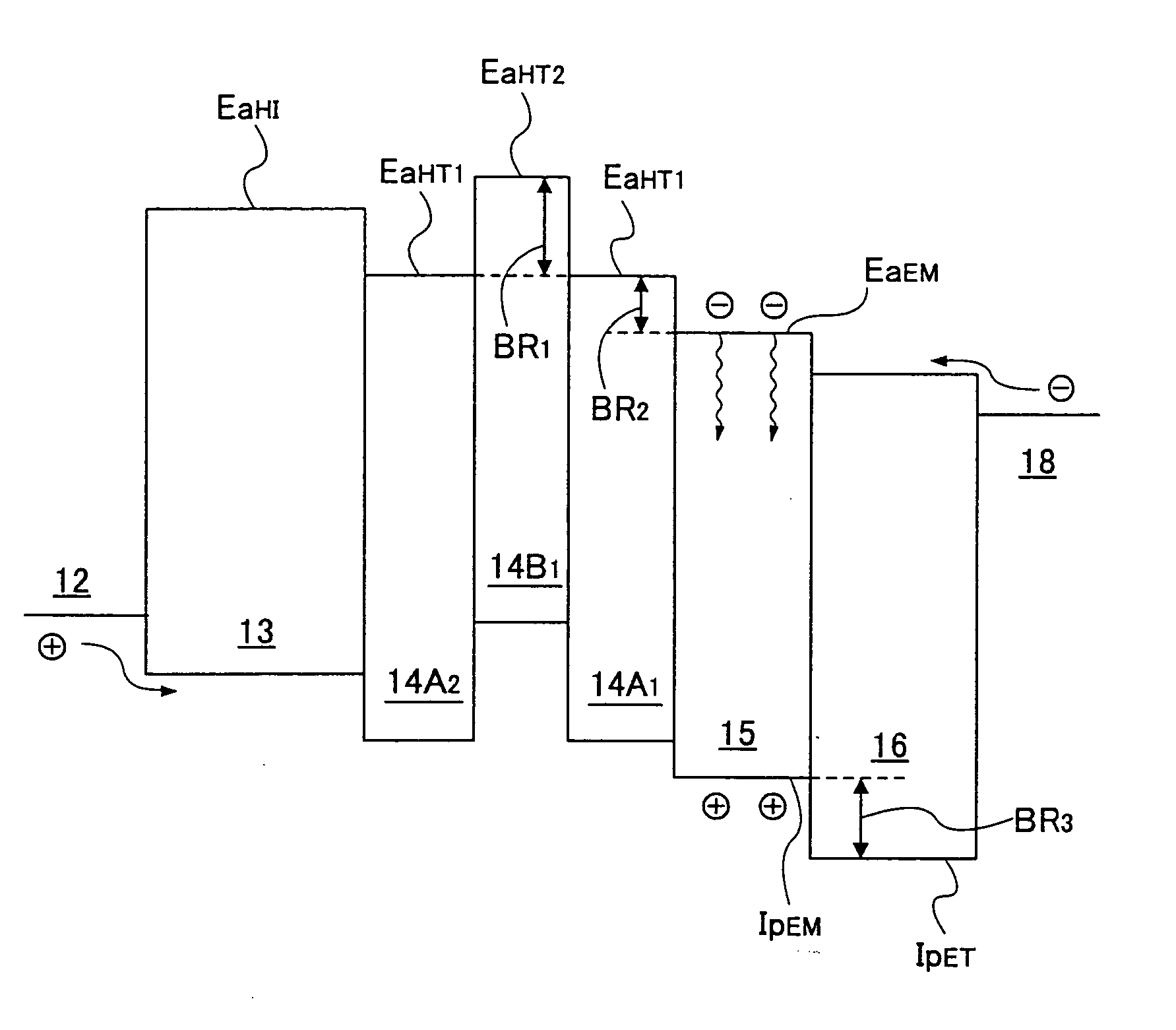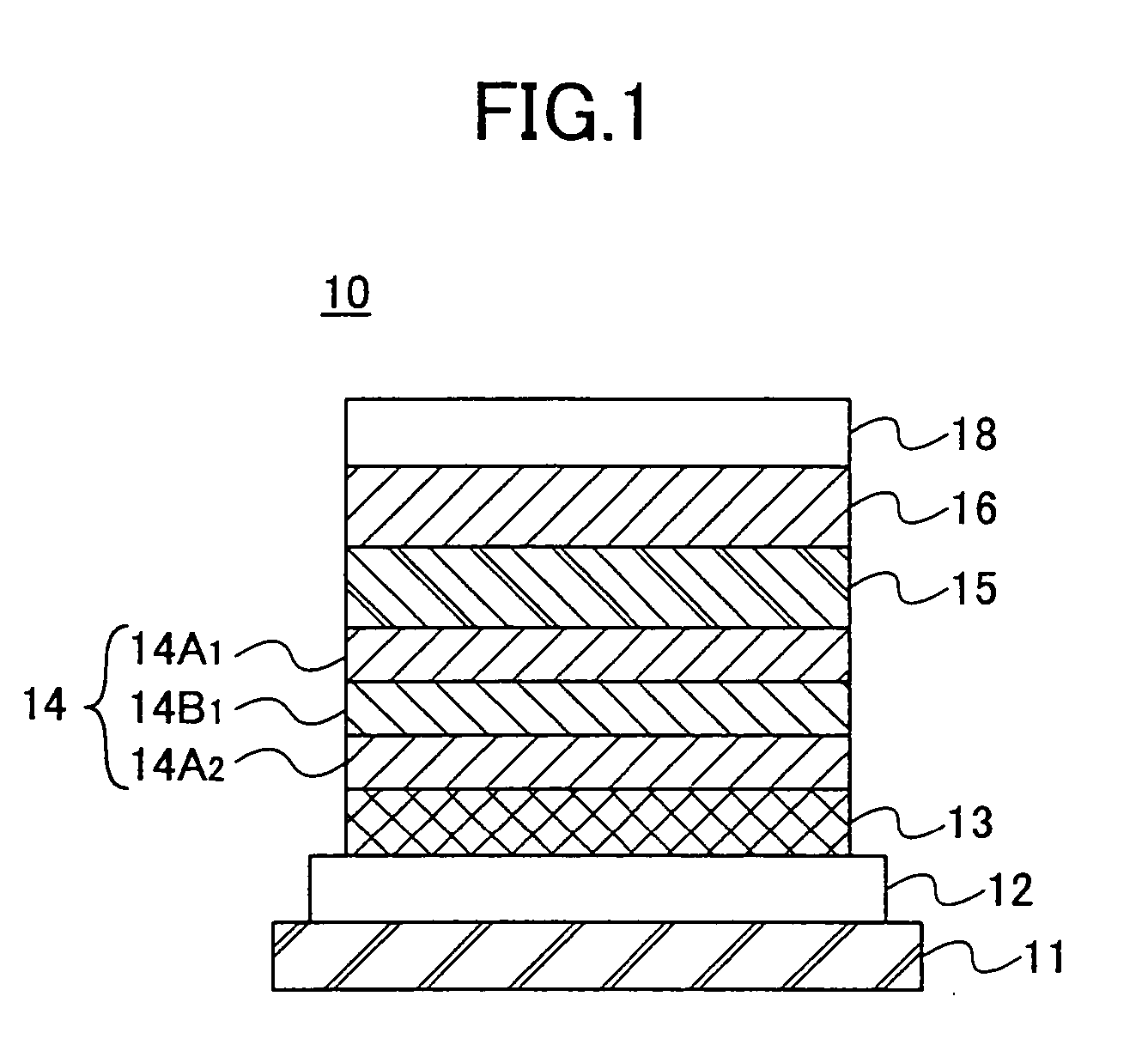Organic electroluminescence device and organic electroluminescence display
a technology of electroluminescence display and electroluminescence device, which is applied in the direction of discharge tube luminescnet display, natural mineral layered products, transportation and packaging, etc., can solve the problems of increased drive voltage, short circuit, and reduced light-emitting luminance, and achieves superior light-emitting efficiency and long service life.
- Summary
- Abstract
- Description
- Claims
- Application Information
AI Technical Summary
Benefits of technology
Problems solved by technology
Method used
Image
Examples
first embodiment
A First Embodiment
[0030]FIG. 1 is a cross-sectional view of an organic EL device according to the first embodiment of the present invention. FIG. 2 is an energy diagram of the organic EL device according to the first embodiment as illustrated in FIG. 1. In FIG. 2, Ea denotes the electron affinity and Ip denotes the ionizing potential. Referring to FIGS. 1 and 2, an organic EL device 10 is configured with a substrate 11, an anode 12, a hole-injecting layer 13, an electron-transporting suppressing stack 14, a light-emitting layer 15, an electron-transporting layer 16 and a cathode 18 that are sequentially formed on the substrate 11.
[0031] The organic EL device 10 of the present invention has the hole-injecting layer 13 composed of a hole-transporting material that is doped with acceptors. The hole-injecting layer 13 is, for example 2-TNATA(4,4′,4″-tris(2-naphthylphenylanimo)triphenylamine), a hole-transporting material doped with inorganic materials such as halogen metal compounds, h...
first example
A First Example
[0067] The organic EL device according to the present example is composed from an ITO anode, a hole-injecting layer, an electron-transporting suppressing stack consisting of three electron-transporting suppressing layers, a light-emitting layer, and a cathode that are formed on a transparent substrate.
[0068] A glass substrate with an ITO electrode is supersonically cleansed with water, acetone, and isopropylalcohol, and the surface of the anode is irradiated with UV light in the atmosphere for 20 minutes so as to perform a UV ozone process. Then using a vacuum-deposition apparatus with a vacuum of 1×10−6 torr and a substrate temperature at 20° C., 2-TNATA and F4-TCNQ as the hole injecting layers are simultaneously deposited at the respective deposition rate of 0.5 nm / s and 0.0005 nm / s and are each set to have the thickness of 120 nm. In other words, with 2-TNATA being 100 vol. %, the content of F4-TCNQ was set at 0.1 vol. %.
[0069] Then, the electron-transporting sup...
second embodiment
A Second Embodiment
[0075]FIG. 8 is an exploded perspective view of the organic EL display according to the second embodiment of the present invention. Referring to FIG. 8, an organic EL display 30 is configured with a glass substrate 31, and a cathode 32 formed on the glass substrate in a stripe shape, an anode 34 formed vertically opposing the cathode 31 in a stripe shape, and a stack 33, etc., formed between the cathode 32 and the anode 34. Moreover, the organic EL display 30 is configured with a drive circuit (not illustrated) for driving a voltage to be applied between the cathode and the anode, and an encapsulated container, etc., for preventing exposure to moisture.
[0076] In the organic EL display 30 a voltage is applied to the cathode 32 and the anode 34 of a desired region causing emitting light in the desired region. The feature of the organic EL display is that the organic EL device consisting of the anode 34, the stack 33 and the cathode 32 is composed from the organic E...
PUM
| Property | Measurement | Unit |
|---|---|---|
| Thickness | aaaaa | aaaaa |
| Thickness | aaaaa | aaaaa |
| Electron affinity | aaaaa | aaaaa |
Abstract
Description
Claims
Application Information
 Login to View More
Login to View More - R&D
- Intellectual Property
- Life Sciences
- Materials
- Tech Scout
- Unparalleled Data Quality
- Higher Quality Content
- 60% Fewer Hallucinations
Browse by: Latest US Patents, China's latest patents, Technical Efficacy Thesaurus, Application Domain, Technology Topic, Popular Technical Reports.
© 2025 PatSnap. All rights reserved.Legal|Privacy policy|Modern Slavery Act Transparency Statement|Sitemap|About US| Contact US: help@patsnap.com



